

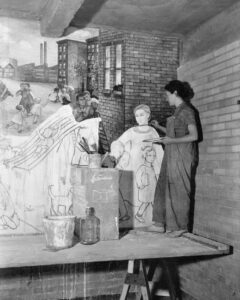
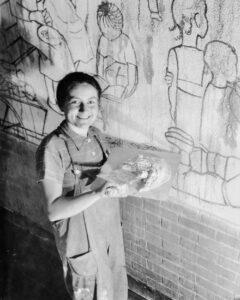
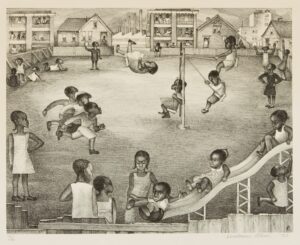

This is a detail of the center of Lucienne Bloch’s mural
“Cycle of a Woman’s Life” sponsored by the WPA in the mid 1930s. Above are photographs of Bloch painting the mural.
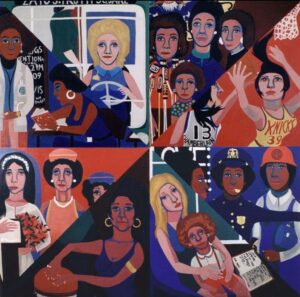
Here is Faith Ringgold’s mural “For the Woman’s House,” also painted in a woman’s prison, in 1972. It was her first public art commission.
Both artists consulted inmates about the content of the mural.
Bloch’s mural showed an ideal life of children playing happily together in a playground.
Ringgold shows careers that the women thought were “outside their reach” as the NYTimes article puts it. Not sure if that is accurate, why not careers they might want to aspire to have when they got out of prison.
Both artists wanted to alleviate the dreadful environment in which the inmates found themselves.
Bloch’s mural was covered up almost immediately, the claim of the administrators was that it gave the inmates false hope. when the prison was demolished, it disappeared forever.
Ringgold’s mural at Rikers has been moved several times. It is currently being moved to the Brooklyn Museum.
Art Historian Michele Bogart stated ” I keep wondering if they are doing a disservice to the people who are still at Rikers.”
Both of these artists believe that art can make a difference.
Bloch worked with Rivera on his mural at Rockefeller Center before it was demolished.
Ringgold has spent her whole life engaging in art with social content. Early in her career she created work on fabric she could roll up and bring with her to save the cost of shipping,so, she said she could collect that money as an honorarium.I remember hearing her speak about this in Austin Texas in 1978.
Bloch worked for the WPA during the 1930s, then spent her whole life making murals and teaching workshops on mural making. I was fortunate to attend one of those late in her life in El Paso, Texas, as well as to go to a one person show she had in California. Here is Bloch with her lifelong love and partner in art Stephen Dimitroff in El Paso.
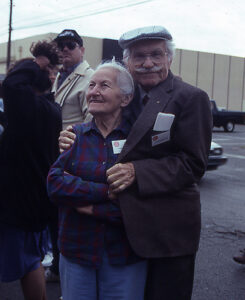
The real tragedy of this story is the prison itself. The prison where Bloch worked was intended to be an ideal new prison, but it deteriorated into a dreadful place and was demolished in the 1970s
Ringgold’s mural was moved several times, after it was threatened, then it was also covered up.
We all know how ghastly Rikers is as a prison.
Where can art fit in these places? I know of artists who do art in prisons with the prisoners, art and poetry, and drama, and other creative activities. this may be more productive than painting something on a wall, but the dreariness of these places is hard to fathom.
There are no easy answers. But I respect both Bloch and Ringgold as well as the government entities that sponsored them, for trying to add something positive to a dreadful place.